15/11
Sunday in Tokyo - we wander around like country folk bumping into people and nearly getting run over as we stare at the buildings and the white people.....we visit Yoyogi park where the teddy boys have given over to breakdancers and idol bands. We sit and listen for a long time to a drummer, bassist and guitarist improvising along jazz lines. They and those listening to them cannot help but grin with happiness as the sun goes down.
16/11

Tamiko does not get up with me this morning as I go out to take a picture of the slightly dilapidated fun fair behind Kaminarimon. Without crowds of people it has a threatening aspect and in one spot near a betting shop an old man is throwing bottles at the pigeons. The sound as they smash carries a long way in the morning air. We spend the rest of the day pretty not doing much, still feeling tired and rather listless after arriving in Tokyo.
17/11
Found a temporary home near Yoyogi park in the form of a weekly mansion and we sit up on a dark bridge at 1.00AM to watch the shooting stars coming out of Leo, these come only every 33 years, so they were last seen the year I was born. The TV predicts hundreds of shooting stars an hour - but the whole thing is something of a disappointment.....we see only four.
18/11 - 24/11
The days become indistinct in Tokyo; although travelling is tiring, so is staying put and we have little energy to do much. However we do manage to visit three sites despite our torpor. At the starting point of Basho's journey, where a statue of the old man looks out over the Sumida river a local businesswoman has parked her car in the spot where I would like to take a picture and I ask her if she wouldn't mind moving it. Tamiko, who is by now long used to my lack of hesitation in asking for things, merely comments on how kind the woman is. At what is now Kita-Senju Basho wrote the second haiku of Oku No Hosomichi:
The birds in sorrow
Fish with eyes full of tears
The passing of spring

There is a map of the Oku No Hosomichi in this unpleasant little children's playground squeezed under the metal framework of a bridge. Even though we ourselves have seen the open beauty of many of the sites on the map it's hard to believe now, as we stand in the midst of this huge city, that they exist.
Before we leave Tokyo we also visit Tamagawa - an uta from the Man'yoshu:
Waving in the waters
Of Tamagawa
Washing clothes
Why do I love her so -

25/11
In a way pleased to be travelling again - packing everything into what I can carry. But certainly part of me has enjoyed the passivity of remaining in one place. I am looking forward to seeing Kanazawa though, of which I've always heard many good things. We are headed north again towards Sado Island. This is a visit that I have been thinking of for quite a few years and all that time it has bothered me how I am going to take a photo of Sado Island with the Milky Way in accordance with Basho's poem. On the way to the coast we stop at Shibukawa. Snow has appeared on the very tops of mountains, while on the lower slopes the autumn leaves are still red.
26/11
Next day Ikaho up on the mountain, nearly lose eachother in the cold, very hard to take a decent photograph of this tourist place.
Even the wind at Ikaho
Sometimes disappears -
But my love for you will never cease
Anon Man'yoshu #3422
However Tonegawa back in Shibukawa in the sunset is gorgeous.
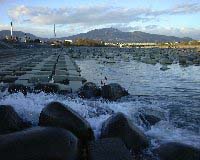
You who I met with heart yearning
I did not know where the shallows were
And crashed into the waves of Tonegawa
Anon Man'yoshu #3413
27/11
The views from the train on the way to Yahiko are in between desolate and gorgeous. But although the scenery is wonderful it is a difficult day with many changes and long stopovers. I can't imagine another country that would have this special mix of conveniance with nature. Finally arrive exhausted in Yahiko expecting to have to really go out of my way to take a decent picture of Sado Island off the coast. The owner of the minshuku is eager to make contact - and we try having a conversation half in English half in Japanese sitting in the empty dining room. I feel embarrassed to tell him all the places I've been when he says that he's never been out of Yahiko. His wife is shouting at him from the corridor to help her with the washing-up until she puts her head round the door and sees me sitting in the corner.
28/11
I get up at 5AM to take a picture of the Milky Way, but it is pouring down. I can hear a steady drumming on the roof which is so loud, at first it's hard to believe water could make so much noise, however a look out the window confirms it. Simoultaneous relief and disappointment as I get back into bed. We spend this wet day looking at Yahiko temple with the hills behind half hidden in mist.
Heavenly Yahiko
Even on a day of blue clouds
A little rain
Anon Man'yoshu #3883
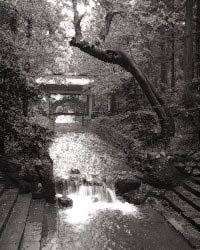
We make another timetable mistake and end up having to wait for two and a half hours at the station. However i am quite happy for this, the weather has cleared up and we sit in the park under the red maple leaves, I spend the time carving a stick, while Tamiko reads. We are headed towards the place where Basho wrote the Sado uta and another chance for me to catch the Milky Way.
Lying over angry seas
And the distant Sado Island -
The arch of the Milky Way
Another difficult night in a minshiku and a disturbing dream in which a bus full of people falls off a cliff and is smashed on black rocks. I try to open the bus doors with my tripod after hesitating to go down to help afraid of the blood and broken limbs I will see. I cannot open the doors and wake up with the thought 'the tripod doesn't work' running through my head. At 4.30 AM The wind and rain outside is of typhoon proportions, which means another lost opportunity. But later, in the dawn, I go out and try to get a decent photo out of a very dull beach. While I am changing the film the tripod topples over and the camera smashes on the rocks.
Basho said hundreds of years ago that the area was desolate and he travelled quickly without writing any haiku until Ichiburi where he invented a fictional night spent under the same roof with concubines. The place is just a few houses in two rows by the sea. There is a school, and while we are standing outside it wondering where our objective is, a Brylcreemed man pulls up in a tinted-windowed car and bizarrely (since we are carrying rucksacks and dressed in heavy weather clothes) asks us if we are primary school teachers. At a modern house further into the village a board outside declares that this was the place Basho purported to have stayed.
Sleeping in one house
Consorts and I
Bush Clover and the moon
Tamiko sits quietly looking out to the ocean while I try to wring an image out of the place. I'm getting increasingly hungry and there is nowhere to eat, but we find a shop that has bread and we eat on the train to Takaoka. After only four days travelling I'm exhausted and happy to collapse onto a hotel bed.
29/11
Wandering around Takaoka. The most interesting thing being a large cast bronze Buddha with an extra wooden head tucked inside itself in a dark chapel in it's base. I thought we might be blessed by it, but if we are it is a strange blessing - when we get back to the hotel we realise that somebody must have pickpocketed us since Tokyo since we are missing some money.
30/11
We visit the Man'yo museum, to check on some poem references. It surprisingly high-tech, with holographic images and sophisticated lighting. Clearly a lot of money has been spent on canonising the literature of the Man'yoshu and the project we are working on seems completely unrelated. Two utamakura sites are nearby; Shokoji temple and the site of a castle -
From my bed in the morning
I can hear singing
While they row their boats
On the Imizu river
Otomo no Yakamochi Man'yoshou #4150
Somewhat incongruously there are a lot of Russians wandering around, and where we have our lunch the owner becomes slightly diffident when in response to him asking where I'm from I say that I am from England. As I speak in Japanese to him and look Asian his expression clouds with suspicion.
At 1AM I am treated, if this is the right word, to two undubbed Greenaway films - a little glimpse of home.
31/11
A lot of sitting around waiting for the weather to clear up. In grey drizzle we go out to Oyabegawa which is heavily used by pulp factories.

Late at night, unable to sleep
A bird cries out
Longing for a nesting place
On the river
Man'yoshu #4146
Huge rusted boxes sweating out smoke and steam, we catch a tram through the industrial area to the larger Shou river and Nago bay where there should be a beautiful view of the snow-covered Tate mountain range. From the guide books we have been using it looks like it would be one of the most beautiful sights of our trip, tantalisingly we saw brief glimpses of the mountains the train when we arrived in Takaoka, but today it's far to cloudy to see anything. Feeling dizzy I get some bread and tinned tea and we sit down by the mouth of the Shou river (called Ogamigawa in the Man'yo period) amongst the rubbish washed up on the beach, mainly hundreds of drinks cans, and have a break.
Red reflected
On the surface of Ogamigawa
Maidens are standing in the shallows
Collecting river reeds
Man'yoshu #4021
In a brief moment of near sunshine I manage to get a picture of the bay and the river watched over by a scruffy ginger tabby.
Sensing that I am getting bored with hanging round Takaoka Tamiko invites me to a party in the hotel room we are staying in. I accept and look forward to jumping up and down on the bed and throwing the TV out of the window - which is my understanding of what parties in hotel rooms consists of.
3/12
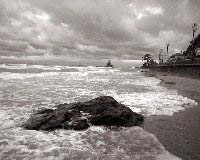
Let us ready the horses
And set out to see
The waves crashing into
The clear bay at Shibutani
Man'yoshu
More dirty weather, and Tateyama continues to be hidden by cloud. We decide though that we cannot afford to spend more time in Takaoka waiting for the weather to change and reluctantly decide to move on to Kanazawa. As we leave, between the platform and the electric lines, we are surprised to see Tateyama shining with snow under the clear but darkening sky.
4/12
Opening the curtains of the hotel window this morning I see the sky is completely cloudless, so we go back to Takaoka for the day. The atmosphere is completely different with the sea calm and blue, and although the scene is beautiful I am happier with the photo I took previously when the weather was awful.
As we miss the train we have to walk back into town and reaching Kanazawa again in the evening we walk around looking for somewhere to eat. We are lucky enough to find a place where the food is cheap but very good, I also have the dubious pleasure of sitting next to a man, who by his behaviour and language, must surely be a local yakuza.
5/12
At the funeral service of a fellow poet in Kanazawa Basho wrote:
The silent grave does not answer
The sound of crying
Or the voice of the autumn wind

The weather has closed in again and although I can see that in better weather it would be nice to spend time here, at the moment the city is slightly oppressive. I have a perverse streak of missing the ease of missing the convenience of towns when I am in the country, and then missing the openess of the country when I am in towns.
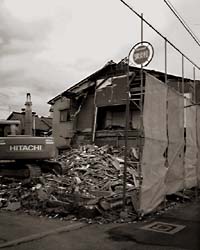
6/12
After a brief look round the city in the morning sunlight we travel up the Noto peninsula to Suzu, another utamakura from the Man'yoshu. The journey takes all day and we arrive at an inn with a room a few yards from the sea. We are the only visitors, and it is thrilling to hear the sound of the waves outside the window in this empty place.
7/12
I have to sneak out of the inn at 5.00AM as, officially, no one is allowed in or out until 7.00. Outside the rocks are conveniently lit by floodlights and a white heron stands absolutely still on the beach. For an hour and a half I experiment with my replacement camera sent from Tokyo. The sun comes up brilliant red.
Dawn light on the sea
Leaving Suzu
We row to Nagahama and there -
The moon on the water
Man'yoshu #4027

Coming back down the peninsula is like coming back down into the world - with all it's faults and agitation.
8/12
We spend the night at Komatsu where we can take a bus to Natadera. For a while we are the only visitors at the temple. As Basho described it 'the entire place was 'filled with strange sights' and the women working there aggressively try to sell Buddhist trinkets and spiritual services. For 2000 yen we can get a Buddha ring that will ward off all bad luck (will not tarnish while washing the dishes), for a 1000 yen we can buy a year's worth of prayers to protect our health.
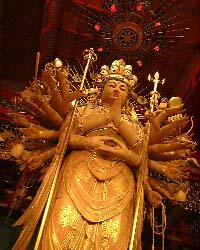
The temple's centrepiece was originally the statue of the bodhisattva Kannon, who has an eye on each of her thousand hands. However, since Basho's visit the temple seems to derive more renown from the rocky hill around which it is built.
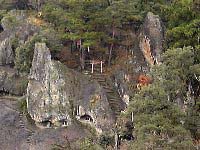
The autumn wind
Blows far whiter
Than the white mountain rocks
The Narrow Road to the North
9/12
Dreary drizzle at Yamanaka, where Basho wrote -
At Yamanaka
Unplucked chrysanthemums
And the scent of the hot springs

We take a long walk by the river Daishoji where we can see the unkempt backs of the spa resorts, and the river water glows a strange milky green. With the grey sky and most of the shops closed it would be nice to stop over at an onsen and relax into a hot spa, but we move on to the town of Daishoji which, apart from the luxury of staying in a modern hotel, is a non-event. The autumn cold has emptied the streets of life.
10/12
At the Myojin shrine at Tsuruga -
Hidden away
In the ever changing sky of the north
The full autumn moon
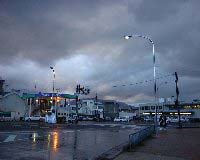
Though the buildings and people may have changed the weather has not, and while I am taking pictures the sky goes through all kinds of convulsions. Rain falls soflty and then suddenly starts pouring - forcing me to give up trying to fight spots of water on the lens and seek shelter. In our dingy hotel room we have a coin-operated TV to look forward to.
11/12
There are only three buses a day to and from our next destination, Iro no Hama, in English Colour Beach, and we decide to go by taxi and then come back by bus. The tourist office at the station tells us that there is nothing there, so we buy box lunches at the supermarket and look forward to a quiet picnic on a deserted beach. The journey there is promising - travelling along the coast there is a low mist over the bay and the hills on the other side slide in and out of view. But when we arrive at Colour Beach, while I am setting up the camera I see dark black clouds moving towards us a white sheet of rain hangs from the clouds and everything behind it disappears. I only have time to press the shutter once before the rain reaches us obliterating the sight of anything that is further than 100 metres away. We spend the next three hours sheltering under the eaves of the empty community centre until the bus comes.
Lonelier even than Suma -
Standing on this beach
The end of autumn
Basho - The Narrow Road to the North
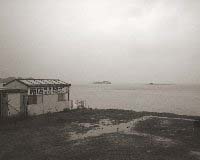
12/12/1998
Ogaki - Basho's last stop on the Oku No Hosomichi. He describes the day as a happy reunion with friends, but his final haiku faintly reflects the sorrow of his first, as, although he finishes the journal of his travels to the north, he continues walking for several months.
As the clam opens in autumn
I must separate from my companions
And travel on
The day for us is horribly drawn out - the day is too bright to take a reasonable picture and we have to wait until sunset walking around listlessly, since we have checked out of the hotel. The six hours stretch out in a daze, the bright sun, harsh shadows and the mundane sounds of the daytime city becoming an increasing irritation. Finally, when the sunlight is soft enough and I have taken a picture we hurry to catch the train to Kyoto. As we near our destination the sites and station names get more familiar until finally we are standing up on a busy local train coming in to Kyoto just as though we are coming back from a day at work. Although I know no one here I allow myself the luxury of feeling that I have come home.
|
|
1998年11月15日〜18日
東北を旅行中ずっと溜まって気になっていた雑用を済ませる。銀行や郵便局へ行ったり、撮影済のフィルム現像をしたり、あっという間だった。浅草のホテルに3泊した間、界隈を歩き回る。雑駁な町で、とてもいい。かっぱえびせんを嬉しそうに、ひたすら食べ続ける浮浪者のおじさんを見ていると、芦屋に住んでいた頃ご近所を縄張りにしていた「百円ばばあ」を思い出す。道行くひとに「百円ちょうだい」とねだってもらった百円で、いちごアイスを買って食べていたおばあちゃんだ。夏でも冬でもいちごアイス、しかもいつでも同じメーカーのもので、どうかすると5つくらい同じアイスが彼女のバスケットに入っているのを見たことがある。いちごアイスをなめなめ、道をゆっくりと歩く彼女の重ね着ルックはよく見ると微妙な色柄使いがすばらしくお洒落でいつも感心していた。今は消費税も5%で百円ではアイス買えないし、彼女も大変だ。
1998年11月19日
昨日から借りたウィークリーマンション最寄りの代々木公園駅から地下鉄で北千住へ。おくの細道への第一歩が踏まれたところ。駅前からタクシーで千住大橋袂の大橋公園へ行く。「生まれも育ちもちゃきちゃき(?)の北千住っ子だい」という運転手さんも名前を知らなかっただけあって、直径17歩位の超ミニ公園。ブランコや滑り台はないが、大きなおくのほそ道の全行程地図があり、「ここも行った」「ここも」と威張りあう。
行春や鳥なき魚の目は泪
日本では99年に一度しか見られないという獅子座流星群が、今夜見られるらしい。雨のように流星が降ってくるらしい。ニュースによると。いそいそと午前2時に起きて代々木公園へ星を見に行く。あちこちの暗闇にグループがひそんでいるらしく、星が流れるたび、うおーと歓声が上がっていた。10歳くらいのちびっこもお父さんと見ている。歩道橋の上から、30分で4つ流れ星を見た。東京の夜空も悪くない。
1998年11月20日
陸奥の旅へ出発する前に芭蕉が住んでいた深川へ。地下鉄新宿線森下駅から徒歩でまずは芭蕉記念館へ向かう。100円払って館内を見物した後、裏木戸から隅田川沿いの遊歩道を歩く。隅田川はまんまん。畳3畳分位のコブのような波がどうどうと川壁に押し当たっている。深い深い緑色だ。その上を赤い夕日が沈んでいくのを眺める。
草の戸も住替る代ぞひなの家
1998年11月21日
JRで武蔵野市に行く。武蔵境という駅で降り付近を歩きまわり撮影。どこもそうだが、駅前を少し離れると古くからの住宅地があってなかなか面白い。うろうろ歩いていると、「第一X荘」「第四X荘」と、Xさん名の築古年的アパートがやたらといっぱいある。?のまま更に歩くと、唐突に門構えも古めかしく立派なお屋敷が現れ表札を見ると、「X」さんだった。!である。地主さんだったのだ。なるほど。すごい。気が付いただけで「第七」くらいまであったし、どうもまだまだ有りそうな気がした。各10戸ずつとしても、Xさんの家賃収入は相当なものだ。余計なお世話か。
武蔵野の草は諸向きかもかくも君がまにまに吾は寄りにしを
武蔵境から西武多摩川線で多摩川の撮影に向かう。地図を見ると最寄りの駅は競艇場前なので、そこで降りて川に向かって歩く。都内とは思えない程広い空と山に囲まれて、多摩川はゆったりと流れている。
多摩川に曝す手作さらさらに何そこの児のここだ愛しき
勤め人らしいおじさんが何人か釣りをしている。友達同士ではないが顔見知りらしく、明日も来るのお?いや、明日はヤボ用で、などと言い合っている。ここでだけの、名前も知らないようなお付き合い、と言ったところか。よく知らない人とものんびり言葉を交わすようなゆっくりした雰囲気が、確かにここにはあると思う。
1998年11月21日
東京在住の友人に、一番人気の観光スポットお台場へ連れていってもらう。どうして地名に「お」がつくのか不思議だ。東京湾の写真を撮ろうとするが光が冴えないので何も撮らない。
そのまま地下鉄で月島へ。隅田川を再び撮るため。やはり、光線の具合がだめらしい。今日はだめだと諦めて、一度食べてみたかった「もんじゃ焼き」を食べて帰宅。食べ方皆目見当もつかず、関西人とバレてしまうと恐れつつおばちゃんに尋ねると、先生が生徒を教え諭すように教えてくれた。よく見ると周りの人々もわからないらしく、おばちゃん先生はあちこちで活躍していた。
1998年11月22、23日
東京出発に備えてまたも種々雑用。そろそろ冬風がきつくなってきたので防寒用品を整えたり、このWebsite編集をしたり、いろんな人に連絡をとったり、これからの旅行分の資料を揃えたり、なんやかや忙しい。東京にはちょうど10日いたことになるが、東北を動き回っていた頃より時間の流れる速度が3.5倍くらいに感じた。旅という異空間のせいか、東京というお化け都市のせいか。
1998年11月24日
池袋駅から高崎線を何回か乗り換えて群馬の渋川着。伊香保温泉まで行くつもりだったが、予約も入れてないし、日も暮れてしまったので、渋川のホテルに泊まることにする。
渋川泊
1998年11月25日
バスで20分の伊香保温泉へ。与謝野晶子が歌った通り、「屋根の上に屋根」「部屋の上に部屋」の坂だらけの温泉だ。車一台やっとの道や人独りやっとの道が縦横斜めに走っていて迷路のようだが、不思議とどの道もどこか見知っている道と繋がっていて迷子にはならない。と思っていたらJohnを見失ってしまう。探し疲れて石段に座り込んだら雪が降ってきた。仁丹くらいの大きな粒の雪が、落ち葉と一緒にふわりと舞い下りてくる。
伊香保風吹く日吹かぬ日ありといへど吾が恋のみし時無かりけり
バスで駅まで戻ってタクシーで利根川に行く。川沿いの市民ゴルフクラブ脇でおろしてもらい、川まで歩く。防波堤に腰掛けて周りの景色を眺めようとするが、風がすごくて時々ちらっと上目遣いでしか見られない。夕焼けで山がピンク色に染まっている。雲もピンク。
利根川の川瀬も知らずただ渡り波にあふのす逢へる君かも
伊香保ろのそひの榛原ねもころに将来をな兼ねそ現在し善かば
渋川泊
1998年11月26日
今日は長旅の日。JRで一気に新潟の弥彦へ向かう。一気にと言っても気分だけで、実は鈍行電車を嫌というほど何度も乗り換え、フニクリ、フニクラと口ずさみたくなるくらいゆっくりと山間を抜けていく。まだ積雪の無い緑色のスキー場もまたをかし。山頂に白く光る雪がここにもどすんと積もるのももうすぐだ。途中のローカル電車では運悪く高校生の帰宅ラッシュにぶつかり、車両全体に響き渡る阿鼻叫喚に発狂しそうになる。田んぼの海を抜けて、山に囲まれた薄闇の弥彦駅に着き駅前の旅館に入ったときにはほっとした。夕食後、村内を散歩。気持ちのいいところだ。
弥彦泊
1998年11月27日
地図で見るとここから海まではすぐだったが、間に長長と横たわる山を見落としていた。海の歌なので、海に行かねばと朝5時にタクシーを予約したが、起きると大風雨。身支度をして出かけたJohnが諦めて戻ってくる。弥彦山がこんなに高いとは思わなかった。ぐうんと空に向かって聳えている。これに上らないと海が見えないのだ。残念だが、仕方ない。海の写真は出雲崎で写すことにして、弥彦神社へ。聞けば、ここでも万葉集の歌が詠まれているらしい。とてもラッキー。神社の撮影をしている間、ずっと来てみたかった弥彦競輪場をひとりで見に行く。神社から地続きで、競輪場がある。開催期ではなく人のいない静寂の中のギャンブル場は清々しい。バンクの中を一人ひたすらに練習中の選手がいた。
いやひこおのれ神さび青雲の棚引く日すらこさめそぼふる
電車で出雲崎へ。駅を出るとやはり海に近い気配なく不安になるが、タクシーで5分も走り丘を越えると突然目前に民家の屋根越しに広がる海が見えて安心する。山と海に挟まれた細長い土地に細々と集落がある。長方形の積み木を並べたように家が繋がっている。泊まった民宿の3メートル先は日本海。夜中ずっと風と波の音がすごい。ごおとぴゅうが交じり合った轟音。何しろ海が近いので耳慣れないそれらの音とがたがた鳴る窓の音に驚きつつ眠る。
出雲崎泊
1998年11月28日
目覚めるとやはり暴風雨。果敢にも朝食前に撮影に出かけたJohnを迎えに海岸へ行くと下を向きつつ歩いてくる。風で三脚が倒れ愛用マミヤ6が壊れてしまったらしい。しょんぼりしている。悔やんでも仕方ないので朝ご飯を食べる。民宿のちび(男、推定年齢 5歳)が、幼稚園に行きたくないとごねまくりつつ連れていかれたと思ったらすぐに戻ってきた。今日は先生の研修のためお休みらしい。「幼稚園行かない!」と急に愛想が良くなり私に向かって「ウルトラマンシュワッチ」なんかしている。昨日まで恥ずかしがって隠れていたくせに嬉しさのあまりその喜びを分かち合いたいらしい。わかりやすいので一緒に喜んでやる。
荒海や佐渡によこたふ天河
JRで市振へ。無人駅にはもう慣れたが、駅前はおろか周囲100メートル以内に何のお店もないとやはり驚く。ここでラーメンでも食べてお昼にしようと目論んでいたので、おろおろしながら歩いて市振集落まで行き撮影。昔は宿場町として栄えたらしいが、今はおそらく夏の間海水浴客が来るだけなのだろう、民宿がいくつかあるが宿泊者がいる様子はない。歩いているといきなり車から降りてきたおじさんから「市振小学校の先生ですか?」と聞かれる。私はともかくJohnが小学校の先生に見えるのなら、人生やり直して人を見る目を養ったほうがいいかも。と思いつつにっこり微笑んで「いえ、違います。」とだけ答える。お腹も空いているし電車もあまりないのでささっと1時間ほどで撮影を終え、ようやく1軒見つけたヤマザキパンのお店でパンを買い込む。電車で食べるつもり。再び電車に乗り立山連峰の雪景色に見惚れながら高岡へ向かう。
一家に遊女もねたり 萩と月
高岡泊
1998年11月29日
大風雨。最近天気に負け続き。本屋で資料探ししたり、郵便局で荷物を送ったりで一日過ごす。だんだん重くなってきた荷物のため肩凝りがひどくなり辟易していたので薬局に飛び込む。「肩凝りけ。慢性け?」と言いつつおじいさんが薦めてくれた貼り薬を買う。町の規模の割に薬局が多い。さすが越中富山の薬売りのお膝元だ。
高岡泊
1998年11月30日
午前中に高岡市万葉歴史館に行き和歌の資料探し。「家持劇場」なる、電気仕掛けの人形やホログラム、コンピューター制御の照明を駆使したハイテクシアターがあったりしてなかなか楽しい。地下の図書室で万葉集の資料をコピー。高岡は越中国府として大伴家持が5年間在任していた地であり、市をあげて越中万葉の故地として観光誘致をしているらしい。歴史館で貰った市のパンフレットの表紙に「いま 高岡は万葉に燃えている」とわかるようなわからないようなコピーがあった。
その後徒歩で勝興寺へ。雑草がぐいぐい生い茂っていて、手入れが今一つ行き届き過ぎていないところがなかなかよい風情のあるお寺だ。お堂の前で座って本を読んでいるとにゃあと言いながら猫がやってきて、当たり前のように膝の上に上がって丸くなる。自分ちの猫達にも、こんなに親しくされたことがないので感動する。子猫をようやく卒業したくらいのしふしふのお腹を撫でつつ、奈良の不退寺のタマちゃんといい、どうしてお寺の猫はこんなにフレンドリーなのか不思議に思う。
もののふの やそおとめらが くみまがふ 寺井の上の かたかこの花
勝興寺前の国府跡で撮影。今は住宅地のこの辺りを、射水川(小矢部川)が流れていたらしい。
朝床に 聞けば遥けし 射水川 朝漕ぎしつつ 唱ふ船人
ロシア人らしき人達がやたらと通り過ぎていくので不思議に思っていたら、伏木港に船が着くのだそうだ。街にもロシア語の看板がぱらぱらある。
高岡泊
1998年12月1日
小雨の中、昨日バスから見てJohnが魅惑されてしまったパルプ工場の撮影に行く。米島と呼ばれる小矢部川の下流地区は大小の工場が立ち並び、灰色の煙が煙突から絶え間なく吐き出される。雨に煙る工場は陰鬱な美しさだ。
夜ぐたちに 寝覚めてをれば かはせとめ 情もしのに 鳴く千鳥かも
万葉電車と呼ばれる路面電車で左右に揺られながら奈呉の浦と呼ばれた新湊へ。
東の風いたく吹くらし奈呉の海人の 釣する小舟こぎ隠るみゆ
庄川の河口付近を歩きまわって撮影。なんとか雨の合間に撮影できた。
雄神河 くれないにほふ をとめらし あしつきとると 瀬にたたすらし
高岡泊
1998年12月2日
またも大雨。嫌になるが、仕方ないのでホテルでおとなしくしていた。高岡に着いてすぐ手配した新しいマミヤ6が東京から届く。これで安心。
高岡泊
1998年12月3日
まだ雨降る。昨日よりはましなので、とりあえず出かけてみる。JR氷見線で雨晴駅まで行く。皮肉な名前だ。と愚痴っていると降り止んだので、慌てて撮影。さすがに雨雲で立山連峰までは見えないが、激しく打ち寄せる波がなかなかの雰囲気。いつまた降り出してもおかしくない天気だ。空をじろっと見上げると、白と灰色の絵の具だけで3日3晩寝ずに偏執狂的にぺたぺた塗り込めたような雲の厚さだ。それなのにJohnは雲の晴れ間を待つという。1時間風の中でつきあったが手が死にそうになったので、駅に逃げ込んでストーブと仲良くする。
馬並めて いさうち行かな 渋谷の きよき磯みによするなみ見に
電車で一駅戻って越中国分へ。風ますます強まる。雨が降り始め、撮影を諦めて降りかえると、目前にえらくお洒落なイタリアンレストランがあって驚く。私たちのいる砂浜を見下ろす格好でガラス張りになっているため中の人たちも驚いた顔をしてこちらを見ている。そこでお昼を食べ、高岡駅で荷物をとり北陸線で金沢へ向かう。
金沢泊
1998年12月4日
起きると快晴。詐欺に遭ったよう。Johnが雨晴海岸へ戻りたいと言うので、電車1時間かけて戻る。来てみてびっくり。海岸の向こうにくっきりと立山が浮かんでいる。高岡市のスモッグなのか下半分が隠れて上半分の雪で白い部分だけしか見えず、ぽかりと浮かんでいるように見えるのだ。絵に描いたような、という形容詞しか浮かばない。昨日とは海も空もがらりと色を変えている。青い空の下、波の音もからりと明るい気がする。呆然と山と海と空を眺め続けるしかない。
渋谷を 指して我がゆく この濱に 月夜飽きてむ 馬しまし停め
今日は歩いて一駅分戻る。国道沿いに歩き始めたが、途中でトンネルがあり徒歩では行けそうに無い。むかつくが、舗装してない坂道を見つけそれを辿るとトンネルの上を跨いで反対側へ行けるようだ。途中で朽ちたマンション跡やなんだか怪しい匂いのするアンティックショップがあったり、高い位置から立山が見られてかえってよかったかも。越中国分で撮影を終え、昨日と同じ時間の電車で高岡へ戻りまた同じ電車で金沢へ。
金沢泊
1998年12月5日
朝から小雨。くじけそうになりながらも頑張って兼六園へ。一回りしたあと満足して雨宿りのため古本屋で時間潰し。ぶらぶらと武家屋敷跡をまわり、香林坊シアターストリートと呼ばれる映画館の並ぶ小通りを撮影する。金沢ではあまり映画は人気がないのか閑散としていて外から見た限り設備も旧そうだ。
あかあかと日はつれなくも秋の風
犀川沿いを歩いていると、大きな建物の解体現場に出くわす。じっと眺めていると工事のおじさんがやってきて、老舗の旅館だった旨教えてくれる。不景気で店じまいするらしい。中の木材も良いもの使ってんだけど勿体無いねえ、と繰り返している。今や一切が瓦礫だ。
塚も動け我泣声は秋の風
タクシーで近江町市場へ行く。道々運転手さんがいろいろ教えてくれた。金沢は元々浅野川と犀川に挟まれた自然の要塞だが、さらに寺の3分の2を犀川の外側へ、残りを浅野川の外側へ移すことによってそれを強化したとのこと。寺で戦をするのは嫌がられたらしい。成る程。道理でお寺が異様に固まってあるはずだ。
秋涼し手毎にむけや瓜茄子
市場で八百屋を撮影した後、市場内の回転すしを食べる。侮れないおいしさ。
金沢泊
1998年12月6日
午前中東茶屋町を散策。おじさんが手招きするのでふらふらついていくと町内会の餅つきの真っ最中で、搗き立てのよもぎもちを貰って食べる。口から20cmくらい平気で伸びる、もちもちのおもち。「この辺のひとは親切だからね」と自画自賛するおじさんは町内のお世話役らしい。ごちそうさまでした。
午後からJR七尾線で七尾まで行き、能勢鉄道に乗り換えて鵜飼へ。一体いくつあったのだろう、ごとごとゆるゆる進む能勢鉄道の駅で数えられない位停車しながらようやく鵜飼駅へ着いたときは、夕暮れ時だった。駅前には地図もタクシーもなく、徒歩15分とのガイドブックの説明だけを当てに適当な方向に適当に歩いていくとなぜかきっちり国民宿舎に辿り着く。能登半島のはしっこに来てしまったというこちらの感慨を余所に、なんだかやたらと館内に人が多い。? だが、夕食のとき食堂には10人足らずしか人は現れない。? この辺りには外食できそうな食堂や居酒屋も無い。? ちびっこ2人を含む親子連れがお揃いのパジャマ姿でキティーちゃんタオルを首に巻いて玄関を出て行くのを見送りつつやっと謎が解けた。村の人々が温泉だけ入りに来るらしい。それにしても、村民全員いるのではと思われるくらい年代性別入り乱れ、夕方から夜にかけて入れ替わり立ち代わり途切れることがない。国民宿舎が村の社交場なのだ。ここのお風呂で選挙運動やればばっちりだ。夜撮影を終えてゆっくりと温泉につかると、目の高さで海が横たわっている。見付島と呼ばれる小島もしんと薄紫色にライトアップされてすぐそこに見える。
珠洲の海に朝開きして漕ぎ来れば長浜の浦に月照りにけり
珠洲温泉泊
1998年12月7日
目覚めると朝日が眩しくなる一歩前、慌ててタオルをつかみ朝風呂にいき、湯船の中から朝日を眺める。絶景。Johnは日が昇る前から撮影に出てすばらしく綺麗なイメージを撮ったらしく、興奮している。朝食を摂って再び能勢鉄道で後戻り。七尾でJRに乗り換え羽咋駅で下車。タクシーで「海まで」と頼むと運転手さんが躊躇なく連れていってくれたのが、なぎさドライブウェー。8キロも砂浜を車で爆走できる観光名所らしい。次々と砂浜を大型観光バスが走ってくる光景は奇妙だ。「新潟観光バス3台―」「一宮ツアー5台―」大音量スピーカーが始終がなりたて、バスからどやどや降りてきた人達はそのままレストラン及びお土産屋へ連行されている模様。良く出来ている。
志雄道から直越え来れば羽咋の海朝なぎしたり舟梶もがも
JRで小松へ。少し前から頭痛がひどくなり、本を読んで気が付かないフリをしたが、下車して駅から出た途端痛さのあまり座り込んでしまう。「ひとおもいに殺してくれえ」と喚きたくなる痛さ。ホテルにチェックインし薬を飲みベッドに倒れ込む。
小松泊
1998年12月8日
チェックアウト後朝食前に駅前の空き地で撮影。
しほらしき名や小松吹萩すすき
正午のバスで那谷寺へ向かう。小雨のせいか人も疎らで落ち着いたお寺を堪能する。厄除け指輪売りのおばさんにつかまり大阪のデパート顔負けのセールストークを展開されるが、何も買わない。本殿では、「ここにお名前を書いてください」と言われ普通の記帳かと思いペンを手に記入しようとすると、金一千円也とこっそり書いてある。聞くと千円払えば一年間毎朝健康をお祈りしてくれるとのこと。先に言って。「ただでも要りません」と宣言し先に進む。お昼を過ぎると団体客がガイドに連れられ次々やってくる。雨宿りに上がった高台の屋根付き展望台から下を眺めると、寺前にあったお土産屋の名前入りの黄色い傘が連なってうごめいている。巨大黄色マッシュルームだ。
石山の石より白し 秋の風
小松泊
1998年12月9日
JRで加賀温泉駅まで行き、バスに乗り換え山中温泉へ。3分おきに降ったり止んだりを繰り返す変わり易い北陸の天気に遊ばれながら、なんとか雨の合間に撮影。
山中や菊はたおらぬ湯の匂
温泉に入りたいがここは予算オーバーなので諦め、バスで大聖寺駅まで行き駅前のホテルに泊まる。新しい近代的なホテルが何も無い駅前にどんと聳えている。
大聖寺泊
1998年12月10日
荷物を預け徒歩で全昌寺へ。大人300円、小人100円と書いてあり、漢字を見落としたJohnが200円払うとおばさんが笑いながら足りないわよと言うので、英語で彼に説明すると「外国からいらしたの?じゃあ、200円で結構ですよ、おまけです。」と言ってくれる。負けてくれたから言うわけでなく、とてもおっとりした優しい笑顔の人だ。五百羅漢をゆっくり見る。表情や服装が全部違う。500対の目に取り囲まれているのを感じはするが威圧感がない。気持ちが落ち着く空間。本堂にじっと正座してみたらこの旅で初めて、芭蕉と曽良の気配が感じられた。同じ空間を共有している気配。曽良の歌にもある裏山に上ってみたら、石段の苔に足を滑らせあっと思った次の瞬間には既に階段3段分お尻で着地していた。
終宵秋風聞やうらの山
庭掃て出ばや寺に散る柳
電車で敦賀へ。駅前の酒屋さん経営のビジネスホテルにチェックイン。この辺りは、お土産屋さんとか喫茶店がホテルをやっている。歩いて多太神社へ。今日は降ったり止んだりでなく、降ったり晴れたりだ、この前より更に遊ばれている。
名月や北国日和定なき
敦賀泊 昨日の転倒のせいでお尻の右ほっぺが黒くなる。
1998年12月11日
ホテル下の喫茶店でモーニングを食べ、駅に荷物を預けタクシーで色が浜へ。バスは朝6時50分の次は午後1時までないので仕方ない。原子力発電所や気比の松原を通り過ぎ30分ほどで到着。かろうじての晴れ空の下、見たことの無いような綺麗なグリーンの海が広がる。喜びつつJohnが撮影準備する間付近を散歩。念のため雨宿りできそうな場所を下見しておく。民宿と釣宿だけで出来上がった集落らしいが、どこも営業はしていない。宿の前の自動販売機だけがぶうんと微かな音を立てている。引き返そうと振り向いた途端顔に雨粒が当たった。小走りに戻るとJohnもカメラを抱えて走ってくる。喫茶店のようなものはどこにも無かったので、さっき目星をつけておいたコミュニティーセンターの玄関前の軒先で雨宿りさせてもらう。まもなく風雨が台風並みに激しくなる。雨が横向きに降っている。また天気にやられた。とやけになりつつ買ってきたお弁当を半分立ったまま食べる。止むのを待つしかない。本を読んだり歌ったり、寒くなってきたので飛び跳ねたりして時間を過ごす。2時間半のうち2時間はここで遊んだ。バスの時間が近づき体も半分凍った頃小降りになったので、全力疾走で浜へ行き傘の下カメラをセットして撮影強行。どたどた戻りバスに乗ったときには、既に霧で海面が白く煙っている。
寂しさや須磨にかちたる浜の秋
JRで大垣へ。知らなかったが、結構都会。お尻のほっぺは青。
大垣泊
1998年12月12日
今日は本当に久々の快晴。神戸でこばらと京子ちゃんの結婚式の日。おめでとう!
大垣はおくのほそ道むすびの地。私たちのおくのほそ道も、ここで終わりだ。と感慨に浸りつつお昼にとんかつで祝杯をあげ、むすびの地付近を散策。国道沿いの橋の上から川を撮影することにする。川の中を覗くと大きな鯉がうようよいる。おたまじゃくしの団体並みに鯉が固まって泳いでいる。橋の上から餌を与えるらしく、人がいるのを見つけると川下からも川上からもどおっと鯉がやってくる。あいにく今日は日差しが強すぎて時間待ちが必要だと言うので、通りかかった喫茶店でケーキを食べつつ時間を潰す。のんびりした土曜日の午後。
蛤のふたみにわかれ行秋ぞ
夕暮れ時に撮影を終えJRで京都へ。お尻のほっぺは黄色。
京都泊
|






